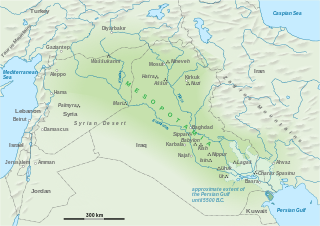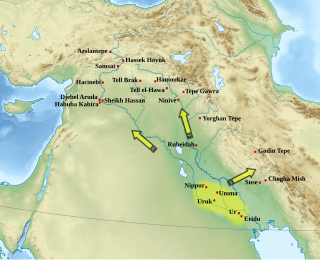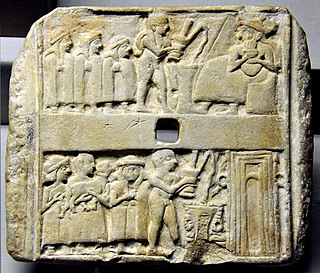Related Research Articles

Mesopotamia is a historical region of Western Asia situated within the Tigris–Euphrates river system, in the northern part of the Fertile Crescent. Today, Mesopotamia occupies modern Iraq. In the broader sense, the historical region included present-day Iraq and parts of present-day Iran, Kuwait, Syria and Turkey.

Inanna is an ancient Mesopotamian goddess of love, beauty, war, and fertility. She is also associated with beauty, sex, divine law, and political power. She was originally worshiped in Sumer under the name "Inanna", and later by the Akkadians, Babylonians, and Assyrians under the name Ishtar. She was known as "the Queen of Heaven" and was the patron goddess of the Eanna temple at the city of Uruk, which was her early main cult center. She was associated with the planet Venus and her most prominent symbols included the lion and the eight-pointed star. Her husband was the god Dumuzid and her sukkal, or personal attendant, was the goddess Ninshubur.

Mesopotamian religion was the original religious beliefs and practices of the civilizations of ancient Mesopotamia, particularly Sumer, Akkad, Assyria and Babylonia between circa 6000 BC and 400 AD. The religious development of Mesopotamia and Mesopotamian culture in general, especially in the south, was not particularly influenced by the movements of the various peoples into and throughout the area. Rather, Mesopotamian religion was a consistent and coherent tradition which adapted to the internal needs of its adherents over millennia of development.

Uruk, also known as Warka or Warkah, was an ancient city of Sumer situated east of the present bed of the Euphrates River on the dried-up ancient channel of the Euphrates 30 km (19 mi) east of modern Samawah, Al-Muthannā, Iraq.

Nergal was a Mesopotamian god worshiped through all periods of Mesopotamian history, from Early Dynastic to Neo-Babylonian times, with a few attestations under indicating his cult survived into the period of Achaemenid domination. He was primarily associated with war, death, and disease and has been described as the "god of inflicted death." He reigned over Kur, the Mesopotamian underworld, depending on the myth either on behalf of his parents Enlil and Ninlil, or in later periods as a result of his marriage with the goddess Ereshkigal. Originally either Mammitum, a goddess possibly connected to frost, or Laṣ, sometimes assumed to be a minor medicine goddess, were regarded as his wife, though other traditions existed, too.

Utu, also known under the Akkadian name Shamash, was the ancient Mesopotamian sun god. He was believed to see everything that happened in the world every day, and was therefore responsible for justice and protection of travelers. As a divine judge, he could be associated with the underworld. Additionally, he could serve as the god of divination, typically alongside the weather god Adad. While he was universally regarded as one of the primary gods, he was particularly venerated in Sippar and Larsa.
Ashnan or Ezina was a Mesopotamian goddess considered to be the personification of grain. She could also be called Ezina-Kusu, which lead to the proposal that the goddess Kusu was initially her epithet which only developed into a distinct figure later on. She was already worshiped in the Uruk period, and appears in documents from many Mesopotamian cities from the third millennium BCE. She is also known from various works of Mesopotamian literature, such as the debate poem Debate between Sheep and Grain.

Lugalbanda was a deified Sumerian king of Uruk who, according to various sources of Mesopotamian literature, was the father of Gilgamesh. Early sources mention his consort Ninsun and his heroic deeds in an expedition to Aratta by King Enmerkar.

The Uruk period existed from the protohistoric Chalcolithic to Early Bronze Age period in the history of Mesopotamia, after the Ubaid period and before the Jemdet Nasr period. Named after the Sumerian city of Uruk, this period saw the emergence of urban life in Mesopotamia and the Sumerian civilization. The late Uruk period saw the gradual emergence of the cuneiform script and corresponds to the Early Bronze Age; it has also been described as the "Protoliterate period".

Nanaya was a Mesopotamian goddess of love, closely associated with Inanna.

The Neo-Babylonian Empire or Second Babylonian Empire, historically known as the Chaldean Empire, was the last polity ruled by monarchs native to Mesopotamia. Beginning with the coronation of Nabopolassar as the King of Babylon in 626 BC and being firmly established through the fall of the Neo-Assyrian Empire in 612 BC, the Neo-Babylonian Empire was conquered by the Achaemenid Persian Empire in 539 BC, marking the collapse of the Chaldean dynasty less than a century after its founding.

Anu or Anum, originally An, was the divine personification of the sky, King of the gods, and ancestor of many of the deities in ancient Mesopotamian religion. He was regarded as a source of both divine and human kingship, and opens the enumerations of deities in many Mesopotamian texts. At the same time, his role was largely passive, and he was not commonly worshiped. It is sometimes proposed that the Eanna temple located in Uruk originally belonged to him, rather than Inanna, but while he is well attested as one of its divine inhabitants, there is no evidence that the main deity of the temple ever changed, and Inanna was already associated with it in the earliest sources. After it declined, a new theological system developed in the same city under Seleucid rule, resulting in Anu being redefined as an active deity. As a result he was actively worshiped by inhabitants of the city in the final centuries of history of ancient Mesopotamia.

Sumerian religion was the religion practiced by the people of Sumer, the first literate civilization of ancient Mesopotamia. The Sumerians regarded their divinities as responsible for all matters pertaining to the natural and social orders.

The art of Mesopotamia has survived in the record from early hunter-gatherer societies on to the Bronze Age cultures of the Sumerian, Akkadian, Babylonian and Assyrian empires. These empires were later replaced in the Iron Age by the Neo-Assyrian and Neo-Babylonian empires. Widely considered to be the cradle of civilization, Mesopotamia brought significant cultural developments, including the oldest examples of writing.
The ancient Mesopotamian deity Bunene, inscribed in cuneiform sumerograms as dḪAR and phonetically as dbu-ne-ne, was a subordinate to and sukkal ("vizier") or charioteer of the sun-god Šamaš, whom he drove from the eastern horizon at dawn to the doorway of the interior of heaven in the west at dusk in a daily ritual. Like his overlord Šamaš, Bunene had a sanctuary, the é.kur.ra, or "House of the Mountain", at Sippar, modern Abu Habbah which was rebuilt by Nabonidus, the last king of the Neo-Babylonian Empire and he also featured in the pantheons at Uruk and Larsa, where his patron was also venerated.

The art of Uruk encompasses the sculptures, seals, pottery, architecture, and other arts produced in Uruk, an ancient city in southern Mesopotamia that thrived during the Uruk period around 4200-3000 BCE. The city continued to develop into the Early Dynastic Period (Mesopotamia) around 2900-2350 BCE. Considered one of the first cities, the site of Uruk – modern-day Warka in Iraq – shows evidence of social stratification, institutionalized religion, a centralized administration, and what art historians would categorize as high art and architecture, the first in the long history of the art of Mesopotamia. Much of the art of Uruk shows a high technical skill and was often made using precious materials.

Egypt–Mesopotamia relations were the relations between the civilisations of ancient Egypt and Mesopotamia, in the Middle East. They seem to have developed from the 4th millennium BCE, starting in the Uruk period for Mesopotamia and the half a millennium younger Gerzean culture of Prehistoric Egypt, and constituted a largely one way body of influences from Mesopotamia into Egypt.

The Temple of Gareus is located in Uruk in Iraq and probably dates to c. 110 AD. It dates back to the Parthian period, and is among the few surviving religious structures of Parthian date in Babylonia. The temple was made of fired bricks and consisted of a single room. The dimensions are 10.7 x 13.7 metres. The original height of the structure is unknown, but the surviving ruins of the structure are over eight metres high. The exterior was decorated with four half-columns with Ionic capitals and vaulted niches in between. In front of the temple's facade, there was a series of six columns. The structure was originally covered in plaster and decorated with a frieze depicting mythical creatures.
The post-imperial period was the final stage of ancient Assyrian history, covering the history of the Assyrian heartland from the fall of the Neo-Assyrian Empire in 609 BC to the final sack and destruction of Assur, Assyria's ancient religious capital, by the Sasanian Empire c. AD 240. There was no independent Assyrian state during this time, with Assur and other Assyrian cities instead falling under the control of the successive Median, Neo-Babylonian, Achaemenid, Seleucid and Parthian empires. The period was marked by the continuance of ancient Assyrian culture, traditions and religion, despite the lack of an Assyrian kingdom. The ancient Assyrian dialect of the Akkadian language went extinct however, completely replaced by Aramaic by the 5th century BC.
Urkayītu, also known as Urkītum, was a Mesopotamian goddess who likely functioned as the divine representation of the city of Uruk. Her name was initially an epithet of Inanna, but later she came to be viewed as a separate goddess. She was closely associated with Uṣur-amāssu, and like her belonged to the pentad of main goddesses of Uruk in the Neo-Babylonian period. She also continued to be worshiped in this city under Achaemenid and Seleucid rule.
References
- ↑ Arno Kose: Uruk: Architektur IV, Von der Seleukiden- bis zur Sasanidenzeit. Zabern, Mainz am Rhein 1998, ISBN 3-8053-1898-7, pp. 291–335
- ↑ Downey, S. B. (1986). "ART IN IRAN iv. PARTHIAN Art". Encyclopaedia Iranica, Vol. II, Fasc. 6. pp. 580–585
- ↑ Armstrong, James A. (1996), "Uruk", in Fagan, Brian M.; Beck, Charlotte; Michaels, George; Scarre, Chris; Silberman, Neil Asher (eds.), The Oxford Companion to Archaeology, Oxford, England: Oxford University Press, pp. 736, ISBN 978-0-19-507618-9